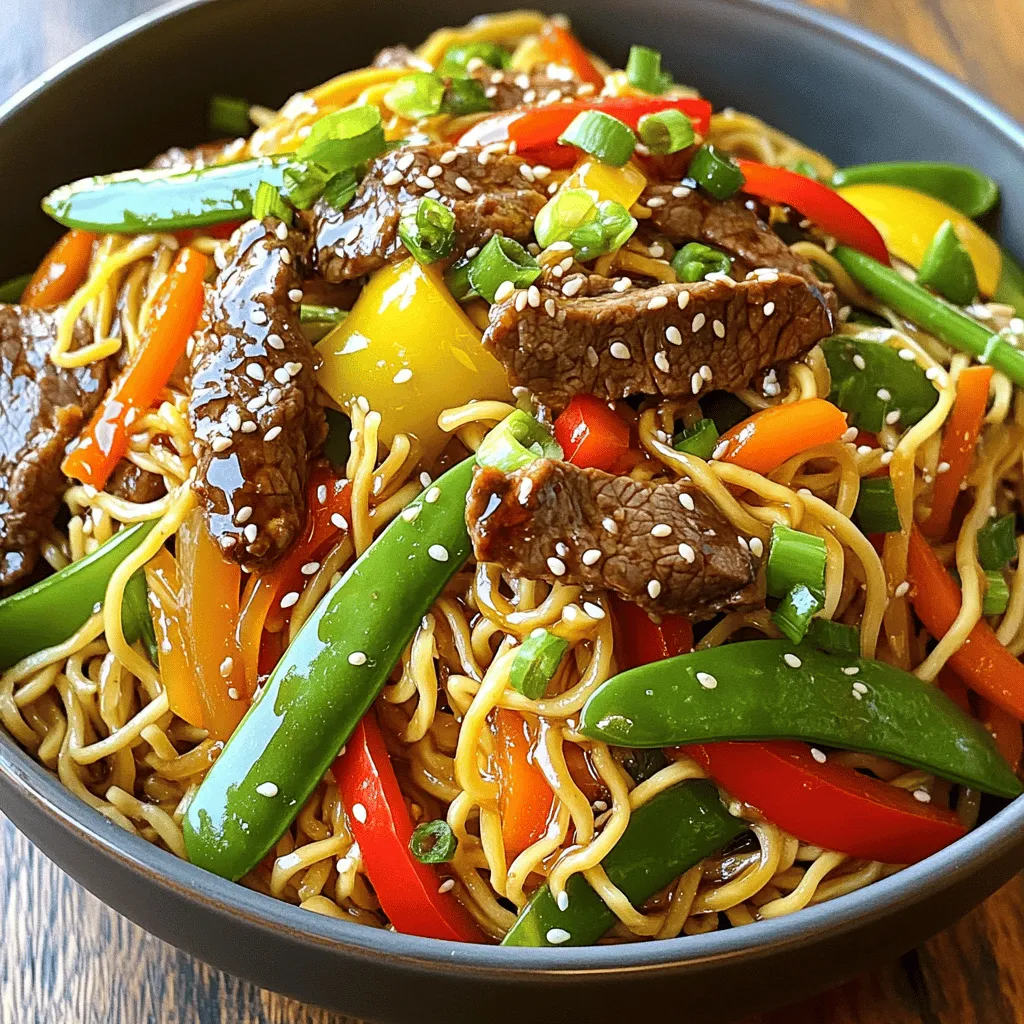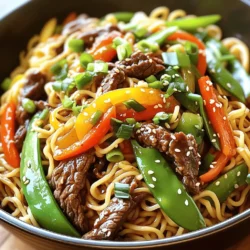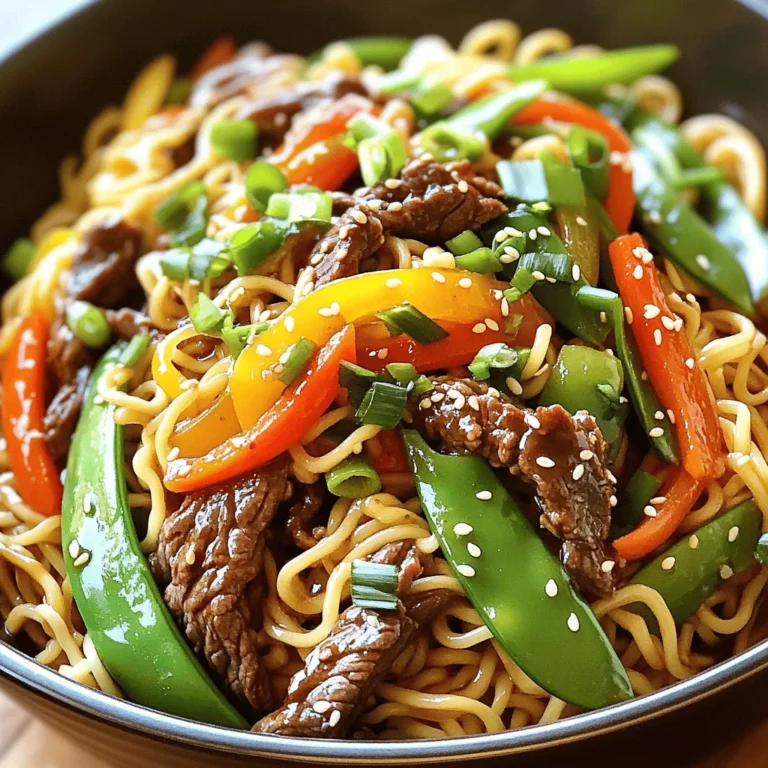Are you tired of takeout that never quite lives up to your expectations? This Beef Chow Mein recipe will change that! With simple steps and fresh ingredients, you can whip up a dish that tastes even better than you can get from your favorite restaurant. Join me as I share my tips and tricks to create a savory, satisfying meal right in your kitchen. Let’s dive into making a Beef Chow Mein that’s truly unforgettable!
Ingredients
List of Main Ingredients
– 8 oz egg noodles or chow mein noodles
– 1 lb beef flank steak, thinly sliced against the grain
– 2 tablespoons soy sauce (low sodium)
– 1 tablespoon oyster sauce
– 1 tablespoon cornstarch
– 2 tablespoons vegetable oil
– 1 bell pepper, sliced (red or green)
– 1 large carrot, julienned
– 1 cup snow peas or sugar snap peas
– 3 green onions, chopped
– 2 cloves garlic, minced
– 1 inch piece of ginger, minced
– Salt and pepper to taste
– Sesame seeds for garnish
Optional Ingredients for Enhanced Flavor
You can add a few ingredients to make your beef chow mein even better. Here are some options:
– 1 tablespoon rice wine or sherry for depth
– A handful of bean sprouts for crunch
– A splash of sesame oil for nuttiness
– Chili paste or flakes for heat
Tips for Freshness and Quality
To make sure your dish is fresh and tasty:
– Use fresh vegetables. Look for bright colors and firm textures.
– Choose high-quality beef. Look for flank steak that is well-marbled.
– Cook your noodles just right. They should be firm but not hard. Overcooked noodles turn mushy.
– Always taste as you go. Adjust seasoning to your liking.
These tips will help you create a beef chow mein that stands out and impresses!
Step-by-Step Instructions
Preparing the Noodles
Start by cooking the egg noodles. Follow the package instructions carefully. Once cooked, drain the noodles and rinse them with cold water. This step stops the cooking process and keeps the noodles firm. Set the noodles aside.
Marinating the Beef
Next, we need to marinate the beef. Take a medium bowl and add the sliced beef. Pour in the low-sodium soy sauce, oyster sauce, and cornstarch. Mix everything well to coat the beef. Let it sit for at least 15 minutes. This helps the beef absorb all the flavors.
Stir-Frying Techniques
Now, let’s stir-fry. Heat one tablespoon of vegetable oil in a large wok or non-stick skillet over high heat. Add the marinated beef in a single layer. Stir-fry for about 2-3 minutes until it turns brown and cooks through. Remove the beef and set it aside.
In the same wok, add the remaining tablespoon of oil. Toss in the minced garlic and ginger. Cook for about 30 seconds until you smell the great aroma. Then add the sliced bell pepper, carrot, and snow peas. Stir-fry these for 4-5 minutes until they are tender yet still crisp.
Lower the heat and add the cooked noodles and beef back into the wok. Gently toss everything together. Make sure the noodles mix well with the beef and vegetables. Season with salt and pepper to taste. If you want extra flavor, drizzle in a bit more soy sauce. Stir for 1-2 minutes to heat everything through.
Now your Beef Chow Mein is ready to serve. Enjoy a meal that’s better than takeout!
Tips & Tricks
How to Achieve the Perfect Marination
To marinate beef well, use the right mix. I use soy sauce, oyster sauce, and cornstarch. This mix adds taste and helps tenderize the meat. Let the beef sit for at least 15 minutes. If you have more time, let it marinate longer for better flavor. The key is to coat each piece well, so it absorbs all the goodness.
Best Cooking Techniques for Beef Chow Mein
For great beef chow mein, cooking at high heat is vital. Use a large wok or skillet for even cooking. Start by heating the oil until it’s hot. Add the beef in a single layer. This helps it brown nicely. Don’t overcrowd the pan; cook in batches if needed. Once the beef is done, remove it before cooking the veggies. This keeps the beef tender and juicy.
Adding Extra Flavor and Texture
To enhance your chow mein, think about adding extra ingredients. Snow peas add a crisp bite, while bell peppers give color. You can also add mushrooms or bean sprouts for more texture. A touch of sesame oil at the end adds a nice nutty flavor. For a kick, try adding chili sauce or fresh herbs like cilantro. Don’t forget to season with salt and pepper to taste!

Variations
Vegetarian Version of Beef Chow Mein
You can make this dish without meat. Just swap the beef for tofu or tempeh. Use the same marinade to flavor the tofu. Cut it into cubes and stir-fry until golden. Add all your veggies like bell peppers and carrots. This method keeps it tasty and satisfying. You still get that great chow mein feel without the beef.
Gluten-Free Alternatives
If you want a gluten-free meal, use rice noodles instead of egg noodles. Check the soy sauce label to ensure it is gluten-free. Tamari is a great option for soy sauce. You can also skip the oyster sauce or find a gluten-free version. With these swaps, you can enjoy chow mein that fits your diet.
Different Protein Options
You can easily change the protein in this dish. Try chicken, shrimp, or even pork. Just remember to adjust the cooking time based on the protein you choose. Chicken cooks faster than beef, while shrimp cooks quickly too. Each option adds a unique flavor to your chow mein, making it fun to experiment.
Storage Info
How to Store Leftovers
To keep your beef chow mein fresh, place it in an airtight container. Let it cool down first. This helps prevent sogginess. Store it in the fridge for up to three days. For best taste, eat it within this time frame.
Reheating Tips for Best Results
When you’re ready to enjoy your leftovers, reheat them gently. Use a skillet over medium heat. Add a splash of water or broth to keep it moist. Stir often until it’s hot. You can also use the microwave. Heat in short bursts of 30 seconds, stirring in between.
Freezing Instructions
If you want to save beef chow mein for later, freezing is a great option. First, let it cool completely. Then, place it in a freezer-safe bag or container. Remove as much air as possible to prevent freezer burn. It will stay good for about three months. To thaw, move it to the fridge overnight before reheating.
FAQs
How do I make beef chow mein less oily?
To make beef chow mein less oily, use less oil when cooking. Start with one tablespoon instead of two. You can also drain excess oil after stir-frying. Another tip is to cook your beef in small batches. This method helps keep the meat from steaming in oil.
You can also use leaner cuts of beef, like sirloin. They have less fat than flank steak. Lastly, choose low-sodium sauces. They often have less oil, which helps cut down on grease.
Can I use other noodles besides chow mein?
Yes, you can use other noodles. Egg noodles work well if you can’t find chow mein noodles. Rice noodles are also a great option. They give a different texture and taste.
If you want something healthier, try using zucchini noodles. They add a fresh crunch and are low in carbs. Just remember to adjust cooking times based on the noodle type you choose.
What’s the secret to restaurant-style chow mein?
The secret to restaurant-style chow mein is high heat and quick cooking. Use a wok for the best results. A hot wok helps the ingredients cook fast and keeps them crisp.
Also, marinate your beef well. This adds flavor and tenderness. Fresh veggies, cut into thin strips, also help. They cook evenly and stay crunchy. Lastly, finish with a drizzle of sesame oil for that authentic taste.
In this post, I covered key ingredients for beef chow mein, with tips for quality. I shared step-by-step instructions and cooking tricks to enhance flavor. You can try variations like vegetarian or gluten-free options too. Lastly, I explained how to store and reheat leftovers effectively.
These tips will help you create tasty meals at home. With practice, your chow mein will rival the best restaurants. Enjoy cooking and tasting your delicious creations!


